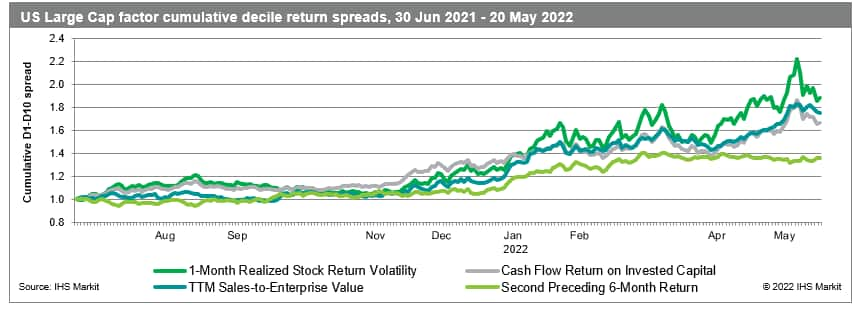Inflating market uncertainty
Research Signals - May 2022
Since the start of 2022, equity markets have given up substantial gains from their impressive run off the March 2020 pandemic low. Recent volatility has stemmed from anxiety surrounding upward pressure on inflation which was intensified by Russia's invasion of Ukraine and renewed supply chain disruptions from COVID-19-related lockdowns in China. As much anticipated, the US Federal Reserve initiated a tightening cycle, including a 50 basis point increase in the federal funds rate in early May and announcement of plans to begin shrinking its balance sheet in June. The Fed also added the sentence "The Committee is highly attentive to inflation risks" and, with this development, we study current market conditions from the frame of heightened inflationary strains.
- Factors favoring low risk and sales-based value metrics, including 1-Month Realized Stock Return Volatility and TTM Sales-to-Enterprise Value, respectively, outperformed on average during previous episodes of the sharpest increases in inflation, consistent with current market results
- The number of stocks trading well below their 52-week highs has steadily increased since November, recently reaching a quarter of our US Total Cap universe (3,000+ stocks), with the largest expansion associated with the long duration Information Technology and Consumer Discretionary sectors
- Analyst outlook has become increasingly negative, with nearly half of the US Total Cap universe recently experiencing net negative earnings revisions for the current fiscal year, affecting a high percentage of Communication Services and Consumer Discretionary constituents, while Energy and Materials sector outlook was more positive

S&P Global provides industry-leading data, software and technology platforms and managed services to tackle some of the most difficult challenges in financial markets. We help our customers better understand complicated markets, reduce risk, operate more efficiently and comply with financial regulation.
This article was published by S&P Global Market Intelligence and not by S&P Global Ratings, which is a separately managed division of S&P Global.